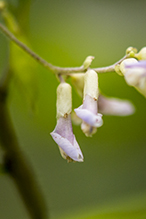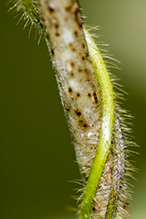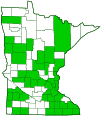lowland hog peanut
(Amphicarpaea bracteata var. comosa)
Conservation • Wetland • Description • Habitat • Ecology • Use • Distribution • Taxonomy
Description |
||
Lowland hog peanut is a sprawling or climbing, 6″ to 60″ long, herbaceous, annual vine that rises from a taproot. It spreads by producing above-ground or underground creeping runners (stolons). The stem is slender, round, light green to reddish green, and covered with spreading, tawny hairs. It does not produce tendrils. It climbs by spiraling clockwise at the tip around the stem of another plant (twining). The leaves are alternate and pinnately divided into 3 leaflets. The leaf stalks (petioles) are slender and ¾″ to 4″ long. At the base of each petiole there is a pair of small appendages (stipules). Each stipule is egg-shaped or lance-shaped, about ⅛″ wide, and ⅛″ to 3 ⁄16″ long. The leaflet stalks of the two lateral leaflets are no more than ⅛″ long, while that of the terminal leaflet is ¾″ to 1½″ long. At the base of each leaflet stalk is a pair of tiny, secondary stipules (stipels). Each leaflet is broadly lance egg-shaped or diamond egg-shaped, 1″ to 4″ long, and ¾″ to 2¾″ wide. The blade tapers to a point at the tip and is broadly rounded, broadly angled or almost straight across, and often uneven at the base. The upper and lower surfaces are hairless or covered with appressed hairs. The margins are untoothed. There are two types of inflorescences. One type is a conspicuous, unbranched, elongated cluster (raceme) of 1 to 17 flowers droops from many of the leaf axils at the end of a ½″ to 2½″ long stalk. The racemes are crowded and are up to 2″ long. Individual flowers are on short stalks that are subtended by a pair of conspicuous bracts. Each flower in the raceme is ½″ to ¾″ long. At the base of the flower there are 5 light green sepals. The sepals are united for most of their length into a tube then divided into 4 lance-shaped or triangular, 1 ⁄32″ to 1 ⁄16″ long lobes. There are 5 pale purple to whitish petals. The petals form a butterfly-like corolla, as is typical of plants in the Pea family. They are organized into a broad banner petal at the top, two narrow, lateral, wing petals, and between the wings two petals fused into a keel. The keel is longer than the wings and is curved upward. The banner is upright, notched at the tip, and folded back along the edges. The other inflorescence type is self-pollinating, closed flowers produced on stolons near the ground level. These flowers have no petals and are inconspicuous. The produce seed pods that are buried in the ground. The aerial fruit (produced from the open flowers) is a pod with 1 to 4 seeds. It is not edible. The pod is ⅝″ to 1½″ long and flattened. There is a short, curved tip (beak) at the end of the pod. The seeds are kidney-shaped and brown. The buried fruit (produced from the closed flowers) is a pod with a single seed. The pod is round, fleshy, and ¼″ to ½″ in diameter. It is edible if cooked. The seed weighs 16 times more than the seed of the aerial pod. |
||
Height |
||
Twining: up to 60″ long |
||
Flower Color |
||
Pale purple to whitish |
||
Similar Species |
||
Hog peanut (Amphicarpaea bracteata var. bracteata) stem is covered with appressed, white hairs, not spreading, tawny hairs. The leaflets are no more than 2½″ long. |
||
Habitat |
||
Moderate moisture to wet. Open woods, thickets, meadows, prairies, roadsides. Full to partial sun. |
||
Ecology |
||
Flowering |
||
August to September |
||
Pests and Diseases |
||
|
||
Use |
||
|
||
Distribution |
||||
|
Sources |
|||
| 5/1/2023 | ||||
Nativity |
||||
Native |
||||
Occurrence |
||||
Common |
||||
Taxonomy |
|||
| Kingdom | Plantae (Plants) | ||
| Subkingdom | Pteridobiotina | ||
| Phylum | Tracheophyta (Vascular Plants) | ||
| Class | Magnoliopsida (Dicots) | ||
Order |
Fabales (Legumes, Milkworts, and Allies) | ||
Family |
Fabaceae (Legumes) | ||
| Subfamily | Faboideae | ||
| Tribe | Phaseoleae | ||
| Subtribe | Glycininae | ||
| Genus | Amphicarpaea | ||
Species |
Amphicarpaea bracteata (American hog peanut) | ||
Subordinate Taxa |
|||
Synonyms |
|||
Amphicarpaea comosa Amphicarpaea pitcheri Falcata comosa Falcata pitcheri Glycine comosa |
|||
Common Names |
|||
American hog peanut American hogpeanut American hog-peanut hog peanut hog-peanut lowland hog peanut |
|||
Glossary
Axil
The upper angle where a branch, stem, leaf stalk, or vein diverges.
Beak
A comparatively short and stout, narrow or prolonged tip on a thickened organ, as on some fruits and seeds.
Bract
Modified leaf at the base of a flower stalk, flower cluster, or inflorescence.
Pinnate
On a compound leaf, having the leaflets arranged on opposite sides of a common stalk. On a bryophyte, having branches evenly arranged on opposite sides of a stem.
Raceme
An unbranched, elongated inflorescence with stalked flowers. The flowers mature from the bottom up.
Sepal
An outer floral leaf, usually green but sometimes colored, at the base of a flower.
Stipel
A small, secondary, stipule-like appendage found at the base of a leaflet stalk.
Stipule
A small, leaf-like, scale-like, glandular, or rarely spiny appendage found at the base of a leaf stalk, usually occurring in pairs and usually dropping soon.
Stolon
An above-ground, creeping stem that grows along the ground and produces roots and sometimes new plants at its nodes. A runner.
Twining
Growing in a spiral usually around a stem of another plant that serves as support.
Visitor Photos |
|||||
Share your photo of this plant. |
|||||
| This button not working for you? Simply email us at info@MinnesotaSeasons.com. Attach one or more photos and, if you like, a caption. |
|||||
|
|||||
MinnesotaSeasons.com Photos |
|||||
Flower |
|||||
 |
|||||
Stem |
|||||
 |
|||||

Slideshows |
||

Visitor Videos |
|||
Share your video of this plant. |
|||
| This button not working for you? Simply email us at info@MinnesotaSeasons.com. Attach a video, a YouTube link, or a cloud storage link. |
|||
Other Videos |
|||

Visitor Sightings |
|||||
Report a sighting of this plant. |
|||||
| This button not working for you? Simply email us at info@MinnesotaSeasons.com. Be sure to include a location. |
|||||
|
|||||
MinnesotaSeasons.com Sightings |
|||||
Charles A. Lindbergh State Park Forestville/Mystery Cave State Park John Peter Hoffman Spring Brook Valley WMA Margherita Preserve-Audubon Prairie Nerstrand Big Woods State Park Northern Tallgrass Prairie NWR, Hoffman Unit Northern Tallgrass Prairie NWR, Rengstorf Unit |
|||||

|
Created: Last Updated: © MinnesotaSeasons.com. All rights reserved. |
